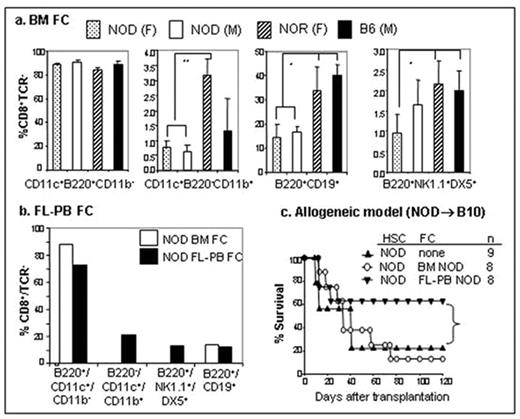Abstract
CD8+/TCR− facilitating cells (FC) enhance engraftment of purified hematopoietic stem cells (HSC) in syngeneic and allogeneic recipients. FC also induce the production of regulatory T cells (Treg) in vivo and in vitro. The B220+/CD11c+/CD11b− precursor plasmacytoid dendritic cell (p-preDC) subpopulation in FC (p-preDC FC) is critical to FC function. However, p-preDC FC are significantly less efficient in function compared to FC total. In this study, we evaluated the phenotype and function of FC from diabetes-prone nonobese diabetes (NOD) mice. We found that NOD FC contain subpopulations similar to those previously described in B6 FC, including p-preDC, CD19+, NK1.1+DX5+ and myeloid cells. P-preDC represent the major FC subpopulation in NOD mice. The CD19+, DX5+ and B220−/CD11c+/CD11b+ subpopulations were significantly decreased in NOD FC compared to those from B6 or NOR mice (Figure 1a; * = P< 0.05; ** = P< 0.007). To test the function of NOD FC, 500 HSC (c-Kit+/Sca-1+/Lin−) were sorted and transplanted with or without 30,000 FC into conditioned 950 cGy recipients. MHC-matched diabetes-resistant NOR mice were served as a control strain for NOD mice. 5 (31%) of 16 recipients of NOR HSC were engrafted and survived up to 130 days. 7 (70%) of 10 recipients of NOR HSC plus FC have long-term engraftment and survival over 130 days, indicating that the NOR FC significantly enhanced engraftment of NOR HSC compared to HSC alone. In striking contrast, NOD FC were functionally impaired and did not enhance HSC engraftment in NOD recipients as evidenced by similar engraftment of HSC with FC (31%, n = 13) compared to the HSC alone (24%, n = 17; P = 0.579). Notably, when NOD mice were treated with Flt3 ligand (FL; 10 μg/ subcutaneous/daily, 10 days), FC were expanded in peripheral blood (PB). The DX5+ and B220−/CD11c+/CD11b+ subpopulations were significantly increased (Figure 1b). The FL-PB FC significantly facilitate engraftment of allogeneic HSC in vivo in the NOD → B10 model (Figure 1c; P = 0.02). These data demonstrate that NOD FC exhibit significantly impaired function and FL plays an important role in regulation and development of FC function. We propose that the defective function of NOD FC is mechanistically due either to the abnormal activation status of the p-preDC FC population and/or the absence of collaborative subpopulations in FC such as NK FC. This hypothesis offers an attractive explanation for the mechanism of FC to enhance HSC engraftment and to induce tolerance. Studies are underway to evaluate the mechanism by which FC contribute to diabetes-pathogenesis and/or prevention.
Author notes
Disclosure: No relevant conflicts of interest to declare.


